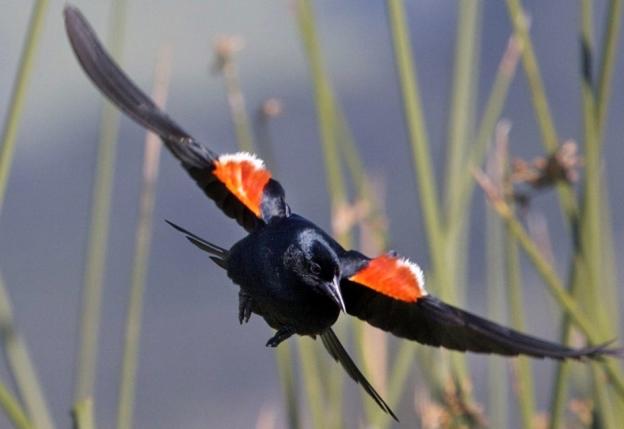
Carolina Parakeet flocks colored the sky like an “atmosphere of gems,” wrote one pioneer in the early 1800s. Daylight-obstructing, miles-long Passenger Pigeon flocks “marked the sky as the buffalo marked the plains,” wrote an early bird conservationist. We know how the story ended for the Carolina Parakeet and Passenger Pigeon. Despite their awe-inspiring numbers — they’re both now extinct.
The Carolina Parakeet and the Passenger Pigeon were unique species, in that they foraged and nested in massive colonies. Unfortunately, this trait was both their strength and their weakness, and only one bird of that kind remains in North America. That’s the Tricolored Blackbird, which lives almost entirely in California. It too was described as “darkening the sky,” by early settlers, but today it is facing plummeting numbers.
Fortunately, we have the chance to prevent history from repeating itself. Next week the California Fish and Game Commission is considering granting the bird a state endangered species listing.
The Tricolored Blackbird is similar to the more widespread Red-winged Blackbird. It is distinguished by its red shoulder patch with a bright white bar and colonial breeding behavior.
Tricolored breeding colonies can teem with more than 50,000 birds, sometimes all settled into a single 10-acre field or wetland to raise their young. The very thing that makes this bird special also puts it at risk.
Each year, Tricolored Blackbirds nest in just a few huge colonies, often in grain fields due to losing 90 percent of its historic habitat. Without incentive to do otherwise, farmers sometimes harvest the fields before the young can fly. A machine harvester can easily wipe out 25 percent of the entire species’ young in just a few minutes.
Audubon California works closely with landowners and its partners in the Tricolored Blackbird Working Group, a collaborative alliance of agricultural associations, governmental agencies, researchers, and conservation organizations, to protect this species.
While a collaborative approach is effective, it can’t solve the emergency situation the bird is currently facing. A statewide survey completed in 2014 showed an alarming 44 percent decline in the species since 2011.
Nothing illustrates the importance of the California Endangered Species Act better than the crisis currently facing the Tricolored. An emergency listing was critical in saving several colonies of nesting birds this past spring.
A century has passed since the last Passenger Pigeon and Carolina Parakeet flocks tested the capacity of Americans to express awe, let’s make sure the Tricolored Blackbird doesn’t share from their fate. Let’s not be the ones who let this bird go extinct when we had the chance to save it.
The Commission should grant endangered species protections to the Tricolored Blackbird.
By Brigid McCormack
Monthly Giving
Our monthly giving program offers the peace of mind that you’re doing your part every day.




